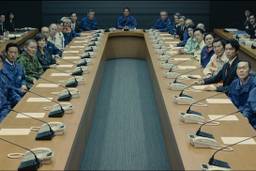Whitewashing Godzilla
The latest adaptation of the classic flick all but ignores the original monster’s anti-nuclear message.
Steve Ryfle

As a new Godzilla (2014) is unleashed upon the world’s multiplexes this week, there is poetic justice in the fact that Ishiro Honda’s 1954 Japanese monster ur-text Gojira is, at the same time, quietly touring U.S. art-house cinemas in commemoration of its 60th anniversary. The Honda film is a reminder of Godzilla’s highly politicized origins, rooted in Cold War tensions and the conflicted postwar relationship between Japan and America. As most everyone now knows, the monster became a simple and crude metaphor for Hiroshima, but Gojira was really a clever and restrained indictment of the doomsday scenario that Harry Truman set in motion. Without ever mentioning the United States, Honda spoke truth to superpower.
But now that Hollywood has, for the second time, spent hundreds of millions of dollars to refashion Japan’s celebrated low-tech monster in its own image (an ironic proposition to begin with), it’s clear that America is incapable of making an honest Godzilla. Consider the ways in which the new movie contorts and distorts history in order to avoid confronting the uncomfortable facts of American culpability in the monster’s origin: It offers a vague scenario in which Godzilla is an ancient sea creature that began appearing after World War II to feed on radioactive material; in footage made to look grainy and faded, the huge beast swims ashore at the Marshall Islands just as a hydrogen bomb is gloriously detonated on a beach. We subsequently learn that the nuclear testing program at the Pacific Proving Ground (comprising 105 atmospheric nuclear explosions from 1947 to 1962, with a total yield of roughly 210 megatons, equal to thousands of Hiroshimas) wasn’t intended to prove the killing power of the world’s most deadly weapons of mass destruction, but “they were trying to kill it”: the whole operation was just a big, unsuccessful Godzilla extermination project. And what of the hundreds of tests performed by the Soviets, British, French, and Chinese during this period? Would the filmmakers have us believe they were trying to kill their own Godzillas?
Perhaps it’s debatable whether Legendary Pictures and Warner Bros. have an obligation to honor Godzilla’s origins after paying untold millions for rights to the character. But given Gojira‘s basis in actual events of the war and its aftermath, the brazen mendacity of the new film’s revisionism is rather astounding. It is not only an affront to the legacy of Honda’s Gojira, but it relies on the audience’s ignorance of and apathy toward history. Its inherent function — one that the screenwriters probably never paused to consider — is to maintain the American historical narrative about the dropping of atomic bombs on Hiroshima and Nagasaki in August 1945, events that needlessly killed nearly 250,000 Japanese civilians yet continue to be falsely remembered as necessary and justified actions to hasten the end of World War II and prevent an invasion of Japan, saving untold thousands of American lives. This narrative began with the U.S. military nearly 60 years ago and has prevailed with the cooperation of the education system and the media, including motion pictures. There have been great antinuclear films such as Dr. Strangelove and Fail Safe, but these assailed the madness of the Mutually Assured Destruction doctrine while avoiding questions about the legitimacy of Hiroshima. Hollywood’s only meaningful challenge to the narrative was the 1983 television film The Day After, which showed Americans being flash-incinerated by a Soviet nuclear attack, and used a doctored photo of the Hiroshima ruins to depict the post-World War III remains of Kansas City. The film was loudly protested by conservative groups, who feared it could endanger President Ronald Reagan’s nuclear arms buildup; the ABC network capitulated by cutting certain scenes and following the broadcast with a panel discussion of Washington right-wingers, who concluded that the film’s true message was that America needed to beef up its arsenal.
The new Godzilla is just the latest effort to negate the monster’s politics for American consumption, a whitewashing that began when Honda’s film was first imported to the U.S. in 1956. The images of death and destruction in Gojira, made nine years after the war, are harrowing references to not only the atomic bombings, but to the fire raids of Tokyo in 1945 and the Lucky Dragon incident of 1954, in which a Japanese trawler was contaminated by the worst nuclear fallout accident in U.S. history. The film shows vast swaths of Tokyo engulfed in flames, and the aftermath of the monster’s attack is a smoldering ruin, resembling photographs of the flattened Hiroshima. A makeshift hospital overflows with the wounded and dying, their skin scorched with radiation, and a doctor waves a clacking Geiger counter over a small child, the most innocent of victims. Godzilla itself was not an animal but a soulless killing machine, a manifestation of the bomb that created it; unlike King Kong or the Beast from 20,000 fathoms, it did not prowl the city looking for its mate or a place to spawn — its purpose was simply to destroy. A Hollywood distributor repackaged the film as low-budget, atomic-age science fiction film of the type so popular at the time, and Godzilla, King of the Monsters! famously included new scenes with Raymond Burr playing a journalist trapped in Godzilla’s path. By placing a bloodied and bandaged Burr in that hospital, this version portrayed America as the monster’s co-victim and thereby blurred references to Hiroshima. The movie was heavily re-edited, and most significantly, a closing speech by a disillusioned scientist (Takashi Shimura, star of Kurosawa’s Seven Samurai) was cut entirely: “If we keep on conducting nuclear tests, it’s possible another Godzilla might appear, somewhere in the world, again.” Certainly the world’s biggest practitioner of such tests wasn’t about to be lectured by a country it had just conquered and turned into a client state.
Then, 30 years later, Japan’s Toho Studios rebooted the franchise in 1984 with a new film, also titled Gojira, which ignored all the sequels, none approaching the import of the original, that had come in between. Godzilla was resituated in a world of heightened Cold War tensions and Reagan’s “peace through strength” mantra; in this outing, an American diplomat pressures Japan’s Prime Minister to abandon the country’s nuclear-free principles and allow the U.S. to attack Godzilla with atomic weapons. A Hollywood distributor with right-wing leanings got hold of the film and again re-cut it, this time with the effect of portraying the Soviet Union as the nuke-happy villains. And finally, there was Hollywood’s first attempt at adapting Godzilla in 1998, a mostly forgettable big-budget film directed by Roland Emmerich and starring Matthew Broderick. This time, Hiroshima was sidestepped entirely, as the filmmakers tied the monster’s appearance to a series of controversial French nuclear tests in Polynesia.
Legendary’s Godzilla is the most egregious of all because, intentionally or not, it manages to turn Honda’s antiwar symbol into a spokes-monster for the nuclear status quo, all the while feigning an interest in the legacy of Hiroshima. In it, the military’s plan to exterminate Godzilla and its foe, the laughably named M.U.T.O. (Massive Unidentified Terrestrial Organism — pity the fine actor David Strathairn, who had to utter those words without chuckling) involves — wait for it — nuclear weapons. Much of the film’s run time involves an inexplicably difficult operation to transport a single warhead, one out of the U.S. arsenal of roughly 4,800, to the desired location. There follows shopworn dialogue, straight out of a 1950s sci-fi flick; actor Ken Watanabe, as a scientist who divines Godzilla’s motives (because, we must assume, he’s Japanese), urges Strathairn’s brass buttons to reconsider the nuclear option. “We tried that before!” Watanabe pleads, and Strathairn retorts, “Millions of lives are at stake!” The climax has the monsters destroying San Francisco, while the assortment of uninteresting characters face a third-act screenwriter’s device borrowed from the 1997 Nicole Kidman-George Clooney actioner (!) The Peacemaker: the nuclear bomb with a ticking timer that can’t be disabled. The hero, a handsome young soldier and family man, gets the nuke onto a boat and out of San Francisco Bay before it detonates just a few miles offshore. We’d been told earlier the bomb is a massive one (“We’re talking megatons,” a commander says), yet the next morning the city’s residents are out and about, rummaging through the wreckage of the Embarcadero, not a speck of fallout anywhere. There was a teachable moment here, but that would have spoiled the happy ending. Instead, the world’s most deadly weapon is just harmless fireworks.
“When the atomic bomb was dropped over Hiroshima, Americans felt both deep satisfaction and deep anxiety, and these responses have coexisted ever since,” write scholars Robert Jay Lifton and Greg Mitchell in the introduction to their landmark study Hiroshima in America: A Half Century of Denial. “Americans continue to experience pride, pain, and confusion over the use of the atomic bomb against Japan … It has never been easy to reconcile dropping the bomb with a sense of ourselves as a decent people. Because this conflict remains unresolved it continues to provoke strong feelings. There is no historical event Americans are more sensitive about. Hiroshima remains a raw nerve.” In our reluctance to prick that nerve, the authors observe, we have accepted a world where thousands of nuclear warheads are aimed at us, where we live in ever-present fear of extinction yet look to those same weapons for safety and survival. The likelihood of another Hiroshima, or many of them, grows.
Shortly before his death in 1993, Ishiro Honda said it had once been his hope that through the metaphor of Godzilla he might provoke a discussion about ending nuclear proliferation, but lamented that he had failed. His pessimism was understandable, and perhaps it was naive to think a monster movie featuring a man in a rubber costume trampling through miniature cities might inspire a serious debate about the dangerous precipice on which we all stand. Still, Honda — a soldier in the Japanese Imperial Army, who often told of passing through a decimated Hiroshima on his way home from the China battlefront — should be remembered for his willingness to challenge the prevailing Hiroshima narrative.
Gareth Edwards, the British director of Legendary’s Godzilla, does the opposite, offering a trite moment wherein Strathairn’s general and Watanabe’s Dr. Serizawa (whose father died at Hiroshima, pegging Serizawa at 69 years old; he looks maybe 50) share a hope that it never happens again, tacitly accepting the gospel of Hiroshima as necessary evil. Edwards says his film’s disaster pornography — digitally realistic images resembling Fukushima, the Indian Ocean tsunami, Katrina, 9/11 — contextualizes the story for our dangerous modern world. But his film does not comment on those images or what they might mean, and so they unspool as hollow exercises in technical prowess. Godzilla is said to be a force of nature reawakened, but by what? Without that answer, the latest Godzilla reboot is about nothing.
This blog was reprinted with permission from World Cinema Paradise.






